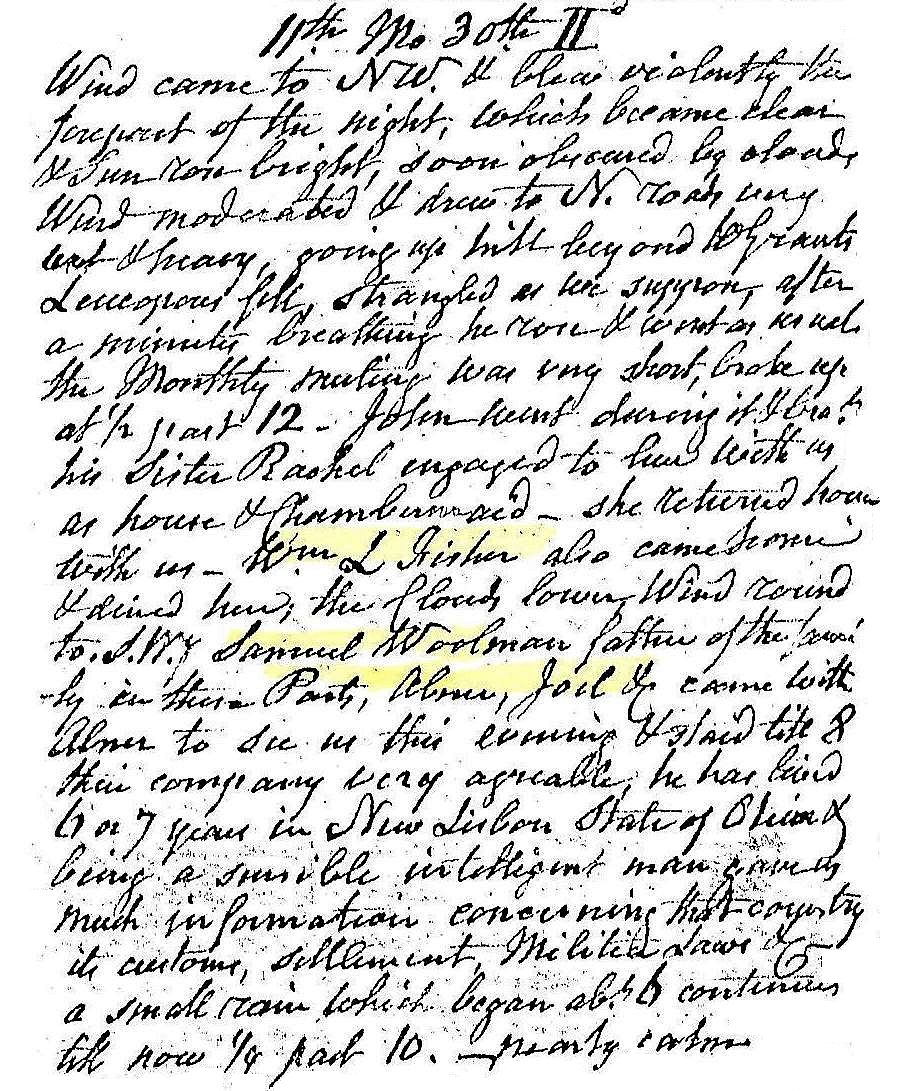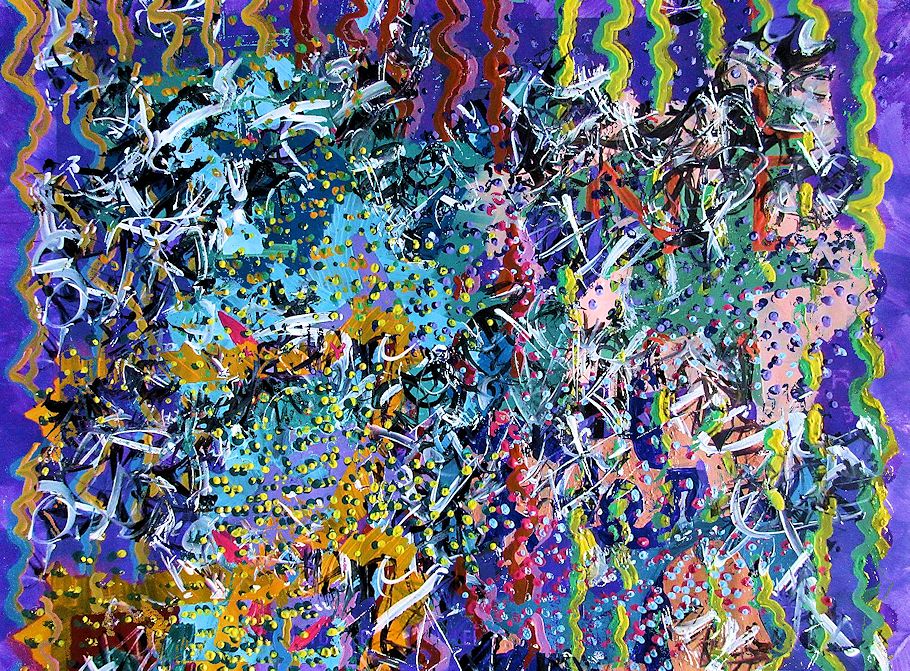30 November 1778 Monday
. . . . . .
30 November 1812 Monday

Wind came to NW and blew violently the forepart of the night, which became clear and sun rose bright, soon obscured by clouds. Wind moderated and drew to N. roads very wet and heavy. Going up hill to Grant's Lucoupous[?] fell, strangled as we suppose[?], after a minute breathing he rose and went as usual. The monthly meeting was very short, broke up 1/2 past 12. John went during it and brought his sister Rachel engaged to live with us as house and Chambermaid. She returned home with us. Wm. L. Fisher also came home and dined here. The clouds lower, wind round to SW. Samuel Woolman, father of the family in these parts. A...., Joel, etc., came with Abner to see us this evening and stayed till 8. This company very agreeable. He has lived 6 or 7 years in New Lisbon, State of Ohio, and being a sensible intelligent man gave us much information concerning that country, its customs, settlement, military laws, etc. A small rain which began about 8 continued till now 1/4 past 10. Nearly calm.
30 November 1994
Piranesi's imagination
On the second night of my conversation with Sue Dixon we talked mainly about Piranesi, and especially his role as a proto-metabolic thinker/designer/etc. In the previous nights conversation we discussed the plurality and the assimilation/metabolism mix of our present time (see note 201). While thinking during the day between our two conversations, it dawned on me more clearly that some physical manifestation of metabolism has been around since the appearance of the kidneys (from 1700 to 1800) (again see note 201). It also dawned on me that Piranesi spans exactly the same period as the beginning of metabolism.
I asked Sue if she would agree that what Piranesi did (especially) in the Ichnographia of the Campo Marzio was to metabolize Roman architecture. After Sue asked me to again define metabolism, she then wholeheartedly agreed that metabolizing was exactly what Piranesi was doing, but not only in the Campo Marzio. Sue immediately talked about Piranesi's chimney pieces and candelabra as designs composed through a breaking down and re-combination of many disparate historical elements.
To further the discussion and as an aside, I mentioned that I believe that the early modern movement in architecture falls much more in the camp of assimilation (absorption and purging), and that only in some (perhaps rare) cases did modern architecture reach the metabolic camp, e.g. I believe Le Corbusier's late architecture is a prime example of how an architect can make the transition from assimilation to metabolism.
Sue then brought up some of Piranesi's other works, namely the Prisons, and I said I thought they were Piranesi's good-bye to assimilation. (I guess after he realized that he was doing something--metabolizing--that was very new and very different than anything that had been around before.) Sue talked about how there is no clear source of patronage for the Prisons, and how that may suggest a more personal involvement on Piranesi's part, and then by extension the Prisons may carry a personal/specific message. Sue also made the point that there are two Prison series (something like 20 years apart), and that they are different in execution, and she was therefore lead to question again if there is a very personal message to be gotten for the two series.
One point that I very much want to make is that Piranesi stands at the head of a new and separate metabolic imagination. Piranesi, therefore, is not a forefather of modern architecture since I believe modern architecture (especially the International Style) is actually a product of the final stages of assimilation. Piranesi's importance in history is still yet to become realized in that metabolism and a metabolizing imagination are exactly what the future holds in store. Piranesi's total influence and worth are not totally known yet, however we can start using the Timepiece to make guesses as to his true legacy.
Piranesi's imagination
Now here are some subsequent questions/ideas about Piranesi in general, and the Campo Marzio in particular:
1. Looking through my book of Piranesi sketches and etchings, I find it sometimes very easy to distinguish between which images relate assimilation and which images relate metabolism.
2. It almost seems that one could say that the overriding argument of his creative output was to demonstrate the emergence of metabolism, and the interplay between assimilation and metabolism, and I will even go so far as to say that Piranesi also gave us a glimpse of what it might be like to leave assimilation behind (i.e. the Prisons).
3. Even though I immediately associated the Prisons with assimilation, I have to admit that I can see a great deal of metabolism in their execution. Of course this points to the fact that there will then have to be a much more cleaver analysis of the Prisons.
4. One way to use the individual plans of the Campo Marzio is to show how they demonstrate metabolism. This would be something along the lines of showing how Piranesi combined disparate architectural elements and created totally new forms of architecture (especially new forms of Roman architecture).
5. Concerning the Campo Marzio publication, the plates with views are of a purged site (i.e. erasure of all Medieval and Renaissance Rome). This purged aspect very much suggests the intestines and (a by-product of?) assimilation. Upon reflection, it seems as if Piranesi had to totally purge the site before he could venture into metabolizing the site.
6. One could look at Piranesi's Views of Rome as counterpoints to the purged views of the Campo Marzio. It is almost as if the Views provide a body of evidence, in their own right, that supports the concept of an metabolizing imagination.
7. Tafuri calls Piranesi's ideas utopian. I find this most interesting because Tafuri indirectly describes Piranesi as a man that designs for the future, and given Piranesi's body of work it is then easy to say that Piranesi designs for the past, present and future. As if looking at the Timepiece, Piranesi can see both the past and the future, and at the same time evoke the spirit of his own time.
8. If Piranesi is to be associated with the beginnings of metabolism, that means he is concurrent with the premier appearance of the kidneys. Now what is most interesting is that the kidneys are the only organs in the digestive system that come in a pair and are situated symmetrically. In fact, the kidneys are the only symmetrical part of the body between the hip bones and the rib cage-lungs-diaphragm.
30 November 2001
ideas
...interpretation of the Ichnographia via The Art of Memory as exercised by the ancients. The Ichnographia as placement of memory, and memory as progenitor of reenactment.
30 November 2019

Fragmented Architectural History Department
30 November 2021

snap of the last one 1 added to 2 added to 3
30 November 2022 Wednesday
. . . . . .
|